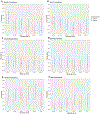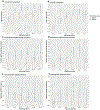The HIV and sexually transmitted infection syndemic following mass scale-up of combination HIV interventions in two communities in southern Uganda: a population-based cross-sectional study
- PMID: 36400088
- PMCID: PMC10068679
- DOI: 10.1016/S2214-109X(22)00424-7
The HIV and sexually transmitted infection syndemic following mass scale-up of combination HIV interventions in two communities in southern Uganda: a population-based cross-sectional study
Abstract
Background: Combination HIV prevention and treatment interventions (CHIs) have led to substantial declines in HIV incidence in sub-Saharan Africa; however, population-level data on non-HIV sexually transmitted infections (STIs) in the context of CHIs are rare. We aimed to assess STI burden following scale-up of CHIs in Uganda.
Methods: The Sexually Transmitted Infection Prevalence Study (STIPS) was a cross-sectional study nested within a population-based cohort among inland agrarian and Lake Victoria fishing populations in southern Uganda. STIPS enrolled consenting residents aged 18-49 years in two communities (one inland and one fishing) between May and October, 2019, and measured the prevalence of chlamydia, gonorrhoea, trichomonas, syphilis, and herpes simplex virus 2 (HSV-2).
Findings: Between May 27, 2019 and Oct 25, 2019, STIPS enrolled 1825 participants. HIV prevalence was 14·0% among the inland population and 39·8% among the fishing population, with about 90% HIV viral load suppression in both communities. Among inland and fishing populations, chlamydia prevalence was 9·6% (95% CI 7·9-11·7) and 9·9% (8·1-12·0), gonorrhoea prevalence 5·0% (3·8-6·7) and 8·4% (6·8-10·5), trichomonas prevalence 9·4% (7·7-11·5) and 12·2% (10·2-14·5), and HSV-2 prevalence 43·0% (39·9-46·3) and 64·4% (61·3-67·6), respectively. In the fishing population, syphilis seropositivity was 24·2% (21·5-27·2) with 9·4% (7·7-11·5) having high-titre (rapid plasma reagin ≥1:8) infection, including 16·9% (11·9-24·0%) of men living with HIV. Prevalence of at least one curable STI (chlamydia, gonorrhoea, trichomonas, or high-titre syphilis) was 51% higher among people living with HIV (vs HIV negative; adjusted prevalence risk ratio [PRR] 1·51; 95% CI 1·27-1·78), including among pregnant women (adjusted PRR 1·87, 1·11-3·17), with no differences by HIV suppression status.
Interpretation: Despite near universal HIV treatment, STI burden remains extremely high in southern Uganda, particularly among people living with HIV. There is an urgent need to integrate STI care with HIV services in African settings.
Funding: National Institutes of Health.
Copyright © 2022 The Author(s). Published by Elsevier Ltd. This is an Open Access article under the CC BY-NC-ND 4.0 license. Published by Elsevier Ltd.. All rights reserved.
Conflict of interest statement
Declaration of interests MJW and RHG are paid consultants to the Rakai Health Sciences Program and serve on its Board of Directors. These arrangements have been reviewed and approved by the Johns Hopkins University in accordance with its conflict of interest policies. YCM has received grant support to John Hopkins University from Hologic, Cepheid, Roche, ChemBio, Becton Dickinson, and miDiagnostics, and has provided consultative support to Abbot. All other authors declare no competing interests.
Figures



Comment in
-
Alarming high prevalence of non-HIV sexually transmitted infections in a rural population of Southern Uganda.Lancet Glob Health. 2022 Dec;10(12):e1701-e1702. doi: 10.1016/S2214-109X(22)00474-0. Lancet Glob Health. 2022. PMID: 36400077 No abstract available.
References
-
- World Health Organization. Sexually Transmitted Infections Fact Sheet. 2021; published online Nov 22. http://who.int/news-room/fact-sheets/detail/sexually-transmitted-infecti... (accessed Jan 20, 2022). - PubMed
-
- GBD 2017 HIV collaborators. Global, regional, and national incidence, prevalence, and mortality of HIV, 1980–2017, and forecasts to 2030, for 195 countries and territories: a systematic analysis for the Global Burden of Diseases, Injuries, and Risk Factors Study 2017. Lancet HIV 2019; 6: e831–e859. - PMC - PubMed
-
- National Overview - Sexually Transmitted Disease Surveillance, 2019. https://www.cdc.gov/std/statistics/2019/overview.htm (accessed Feb 1, 2022).
Publication types
MeSH terms
Grants and funding
LinkOut - more resources
Full Text Sources
Medical

